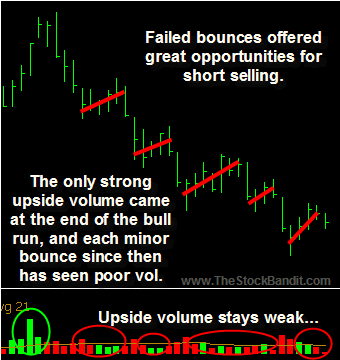Identify Failing Bounces for Short Selling
Traditional Wall Street tells you that the market goes up over time, which has proven to be true. That’s nice if you’re a “long-term investor” who socks money away in mutual funds and doesn’t care about working your capital a little harder.
But for the self-directed trader, it’s important to remember a couple of things. First, the market (and stocks and sectors) will undergo corrections from time to time. Even if a longer-term trend persists, short-term hiccups and even the occasional gasp for air will occur. Second, those corrective phases (or downtrends) offer the best opportunities for short selling if you know what you’re doing.
Flip the Chart if You’re a Bull
You might be predisposed to trading the long side, in which case you’ll certainly relate to this analogy. Within uptrends, buying dips can be an excellent strategy to participate in the move. Doing so allows you to effectively buy on a short-term discount a stock which is in the midst of a longer-term advance. On the flip side, one of the best ways to participate in a profitable way within downtrends is to correctly identify failing bounces.
It’s the mirror-image of buying dips.
Shorting failing bounces can be a great way to trade the dark side, but it does require some finesse and an added dose of patience. These aren’t like breakout plays where you should expect an almost immediate pop and follow through. Rather, they are sometimes more like watching a cruise ship turn around… it might take a couple of days before the direction really changes! With that being the case, these kinds of plays are usually best for swing trading.
The Look
So with the concept laid out before you, let’s talk about what to look for and then I’ll show you an example. What we want to find is a stock which is in fact trending lower. That means lower highs and lower lows are in place, so that support levels have been broken in recent weeks or days with some high-volume selling. Since then, the stock has attempted to bounce back up but has been unable to attain previous relative highs on the chart.
Furthermore, as price goes up in the near term, volume is going down. That creates a negative divergence which shows us that the move is more of a dead-cat bounce as opposed to true accumulation taking place. Often times this establishes a bear flag or rising wedge pattern. As these patterns are confirmed, you’ve got a trade candidate on your hands.
Here’s what good shortable failed bounces look like on the chart, and be sure to notice the lack of solid volume on each bounce attempt:

Chart Courtesy of Blocks
As you find these types of setups, be sure to take notice of the duration of each bounce since stocks will often stick with a certain rhythm in how they move. Also seek to find some sympathy weakness occurring either in the same sector or in the overall market. That way when the time is right, you’ll be putting the odds of success in your favor as you profit from the next decline rather than just endure it.
Trade well out there!
Jeff White
President, The Stock Bandit, Inc.
Swing Trading & Day Trading Service
www.TheStockBandit.com







Fabricio | Aug 22, 2008 | Reply
Hello Jeff.
I`d just like to let you know that I find your posts very interesting. I`ve been reading them for a while now. I started trading in march `07 and your comments and video lessons have helped somehow.
Fabricio, Brazil
TheStockBandit | Aug 22, 2008 | Reply
Hey there Fabricio!
Thanks very much for your nice comments, it’s rewarding to know the posts are helpful to you. And if you aren’t on the free newsletter list already, you’d probably enjoy the videos there as well (see top right portion of this page). Thanks again and good trading to you in Brazil!
Jeff
Richard | Aug 27, 2008 | Reply
What indicators would you recommend when looking to buy a pullback in an uptrend?
TheStockBandit | Aug 27, 2008 | Reply
Hey Richard,
I am not a big indicator guy as I tend to focus primarily on price and volume, but moving averages work well within trends. You might also watch a stochastic for signs of a stock getting oversold within an uptrend.
Thanks for your comment & good luck!
Jeff